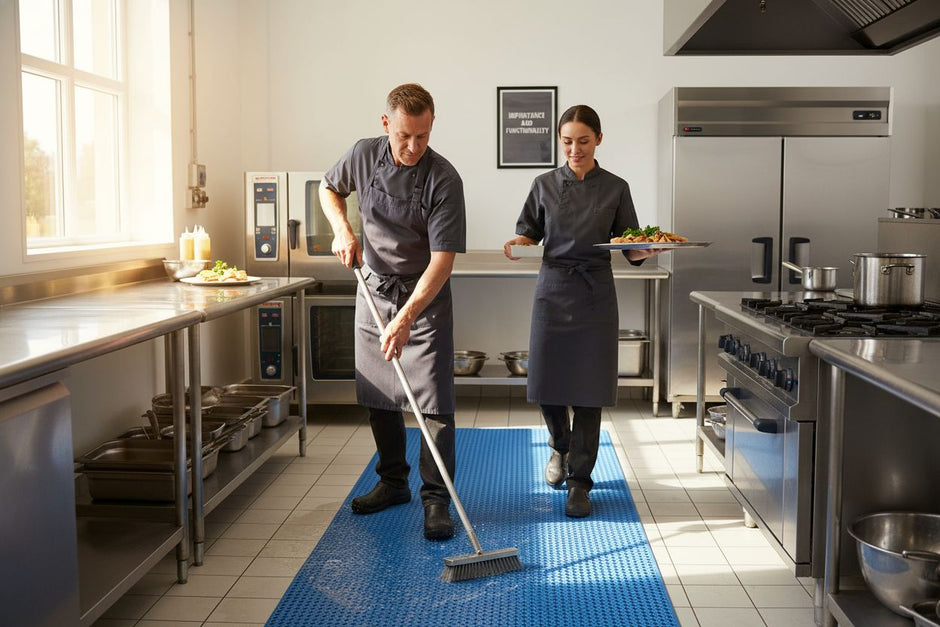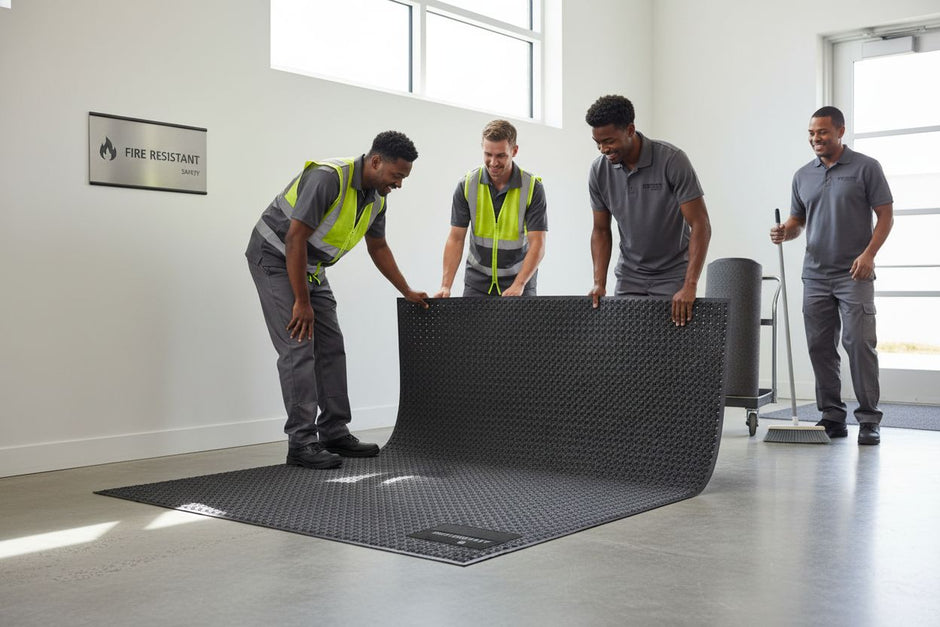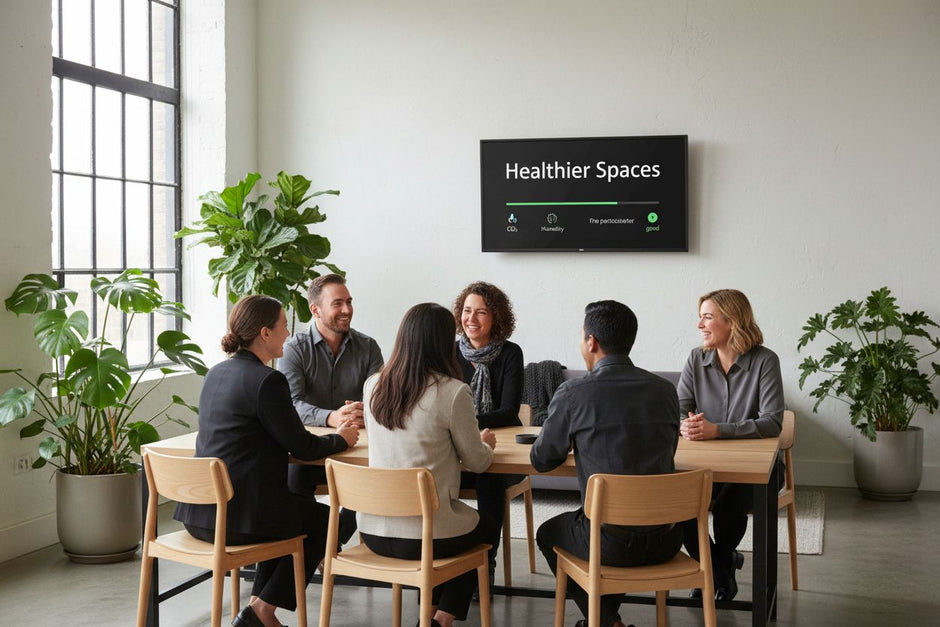Office design might sound like it is just about picking chairs and paint colors. But studies show that thoughtful office layouts can actually improve productivity, reduce worker injuries, and support mental well-being. Most people miss this part: clever office design is really an investment in your team’s potential and success.
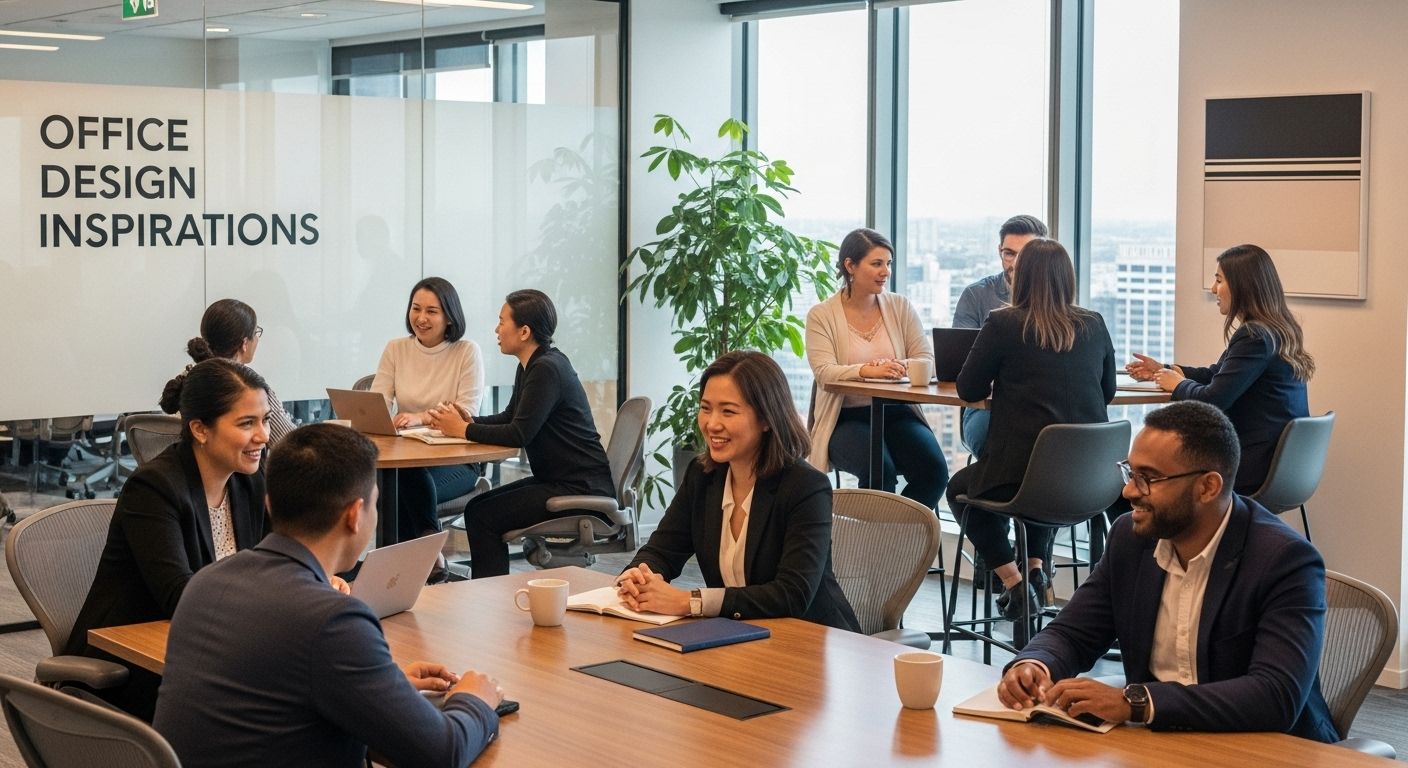
Table of Contents
- The Importance Of Office Design: What Is It And Why It Matters
- Key Elements Of Effective Office Design Inspirations
- How Office Design Influences Employee Well-Being And Productivity
- Exploring Different Styles Of Office Design Inspirations
- The Future Of Office Design: Trends And Innovations
Quick Summary
| Takeaway | Explanation |
|---|---|
| Prioritize ergonomic furniture choices | Ergonomic furniture promotes proper posture, reducing strain and enhancing comfort for employees during work. |
| Design flexible workspaces | Adaptable office layouts support various work styles and team dynamics, improving collaboration and individual productivity. |
| Integrate technology thoughtfully | Seamless technological integration enhances workspace functionality while maintaining a focus on employee comfort and usability. |
| Include diverse work zones | Designated areas for collaboration, privacy, and relaxation cater to different tasks, boosting overall employee satisfaction and performance. |
| Focus on psychological safety | Creating environments that respect individual needs fosters a sense of belonging and enhances motivation, impacting workplace morale positively. |
The Importance of Office Design: What is it and Why it Matters
Office design is more than arranging furniture or selecting color schemes. It represents a strategic approach to creating work environments that support employee performance, well-being, and organizational productivity. Modern businesses recognize that physical workspace directly influences worker motivation, creativity, and overall job satisfaction.
Understanding Office Design Fundamentals
At its core, office design encompasses the intentional planning of physical workspace elements to optimize human interaction, workflow efficiency, and psychological comfort. This holistic approach considers multiple dimensions beyond aesthetics, including ergonomics, spatial configuration, lighting, acoustics, and technological integration.
According to the Centers for Disease Control and Prevention, thoughtful office design significantly impacts employee health and workplace safety. Key considerations include:
- Ergonomic furniture that supports proper posture
- Adequate natural and artificial lighting
- Noise management strategies
- Flexible workspace configurations
Psychological and Productivity Implications
The physical environment profoundly influences psychological states and work performance. Well-designed offices can reduce stress, enhance communication, and foster a sense of belonging. Elements like collaborative spaces, quiet zones, and personalized workstations contribute to creating an environment where employees feel valued and motivated.
Strategic office design recognizes that different tasks require different spatial configurations. Open plan areas might facilitate team collaboration, while private zones support focused individual work. By understanding these nuanced needs, organizations can create adaptive environments that support diverse work styles and cognitive preferences.
Ultimately, office design is an investment in human potential. When businesses prioritize creating thoughtful, human-centered workspaces, they unlock significant potential for innovation, employee engagement, and organizational success.
Key Elements of Effective Office Design Inspirations
Creating an exceptional office environment requires strategic consideration of multiple design elements that work harmoniously to support employee performance, well-being, and organizational culture. Effective office design transcends aesthetic preferences, focusing instead on creating functional, inspiring spaces that adapt to diverse work requirements.
Spatial Configuration and Flexibility
Modern office design emphasizes adaptable workspace configurations that can transform according to different tasks and team dynamics. This approach recognizes that employees require varied environments for collaboration, focused work, and social interaction. Open floor plans with movable furniture, modular workstations, and multipurpose areas enable organizations to create fluid environments that respond to changing workplace needs.
According to research published in the International Journal of Environmental Research and Public Health, effective spatial design considers several critical factors:
- Flexible layout options
- Ergonomic furniture placement
- Zones for different work styles
- Easy reconfiguration capabilities
Technological and Sensory Integration
Contemporary office design inspirations seamlessly integrate technological infrastructure with sensory experiences. This means creating spaces that support digital connectivity while simultaneously addressing human comfort through lighting, acoustics, temperature control, and visual aesthetics. Smart design considers how technology can enhance workspace functionality without overwhelming the human experience.
Key technological considerations include robust wireless networks, easily accessible power outlets, collaborative digital interfaces, soundproofing solutions, and integrated communication technologies that support both in-person and remote work interactions. The goal is creating environments that feel intuitive, responsive, and supportive of modern work practices.
By prioritizing intelligent design that balances technological efficiency with human-centered principles, organizations can develop workspaces that inspire creativity, foster collaboration, and ultimately drive organizational performance.
Understanding the essential elements of effective office design can help organizations prioritize improvements. The following table summarizes the key elements highlighted in the article and their impact on employees.
| Element | Description | Impact on Employees |
|---|---|---|
| Ergonomic Furniture | Supports posture and reduces strain | Enhanced comfort, fewer injuries |
| Flexible Layouts | Adaptable to tasks and team dynamics | Improved collaboration and productivity |
| Technology Integration | Infrastructure for digital connectivity and collaboration | Better usability, supports remote work |
| Diverse Work Zones | Dedicated areas for different work styles | Satisfies various needs, boosts morale |
| Sensory Integration | Lighting, acoustics, and environmental comfort | Reduces stress, improves concentration |
| Biophilic Design & Nature | Incorporation of plants, natural materials, and lighting | Better wellbeing, increased satisfaction |
How Office Design Influences Employee Well-being and Productivity
The connection between physical workspace and human performance represents a critical yet often overlooked aspect of organizational success. Office design extends far beyond aesthetic considerations, emerging as a powerful instrument for shaping employee experiences, psychological states, and professional output.
Psychological Impact of Physical Environment
Workspace design directly influences mental and emotional well-being by creating environments that either support or hinder employee comfort and motivation. Psychological safety emerges through design elements that communicate organizational values, respect individual needs, and foster a sense of belonging. This includes providing spaces that accommodate different work styles, personality types, and cognitive preferences.
According to research from the International Journal of Environmental Research and Public Health, critical psychological design considerations include:
- Creating zones for different energy levels
- Providing visual and acoustic privacy
- Integrating natural elements
- Supporting individual autonomy
Physical Health and Ergonomic Considerations
Ergonomic design plays a fundamental role in maintaining employee physical health and preventing workplace-related injuries. Strategically designed workspaces minimize physical strain, reduce sedentary behavior, and promote movement. Adjustable furniture, proper lighting, standing desk options, and ergonomically designed workstations contribute to reduced physical stress and enhanced worker comfort.
Smart office design recognizes that physical comfort directly translates into cognitive performance. By mitigating physical discomfort, organizations can help employees maintain higher levels of concentration, creativity, and sustained productivity. This approach views workspace design as a proactive health intervention rather than a mere aesthetic choice.
Ultimately, exceptional office design represents an organizational investment in human potential. By creating environments that holistically support physical, psychological, and professional needs, businesses can transform workspaces from passive backdrops into dynamic engines of employee engagement and organizational success.
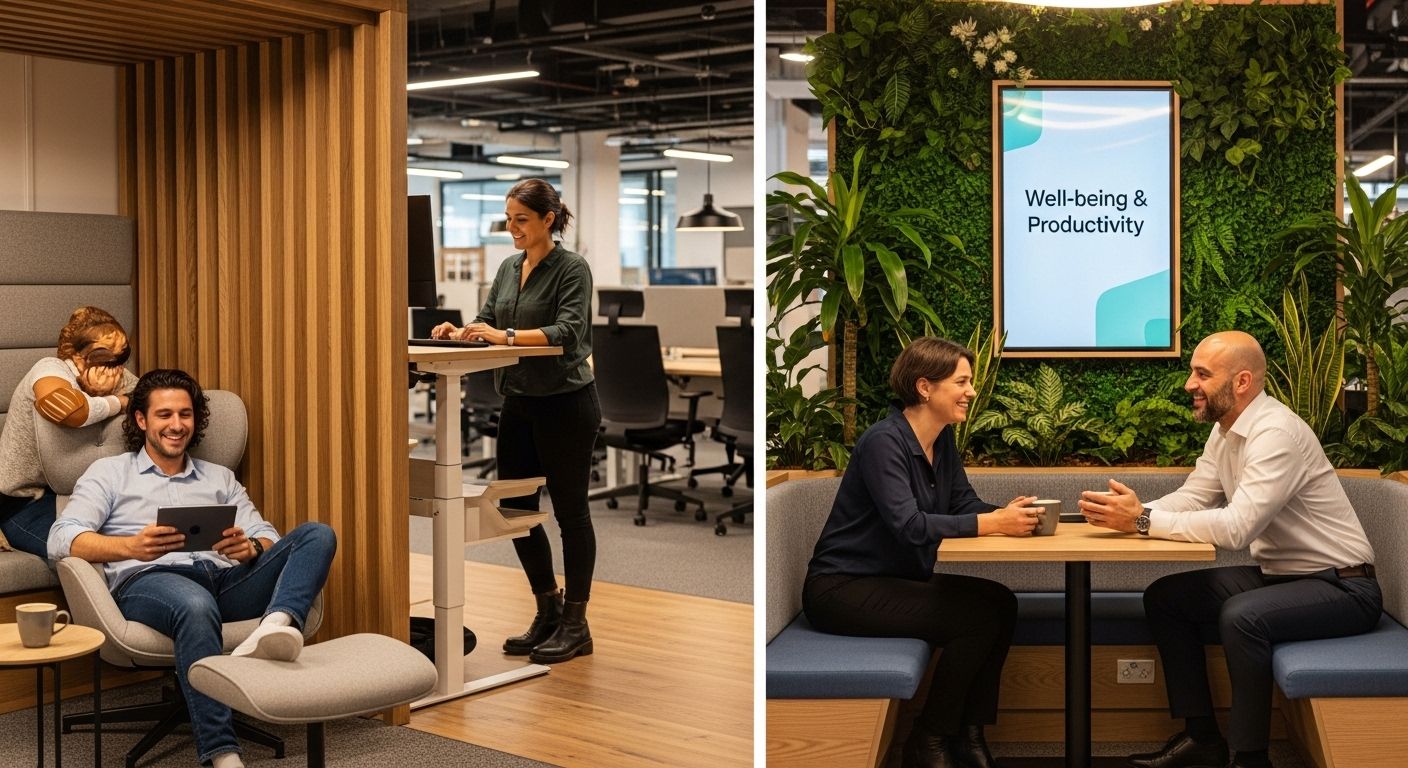
Exploring Different Styles of Office Design Inspirations
Office design is not a one-size-fits-all approach. Different organizational cultures, work styles, and operational needs demand unique spatial configurations that support specific business objectives. Understanding the diverse styles of office design enables companies to create environments that maximize employee potential and organizational effectiveness.
Traditional and Evolving Office Layouts
Traditional office designs typically featured rigid, hierarchical structures with enclosed offices, cubicles, and clear demarcations between management and staff. Contemporary design philosophies challenge these conventional boundaries, promoting more fluid, collaborative, and flexible workspace configurations that reflect modern work dynamics.
According to research exploring office design typologies, office design styles can be categorized into several primary configurations:
- Cell offices with individual rooms
- Shared room arrangements
- Open plan environments
- Hybrid flexible workspaces
- Activity-based working zones
- Hot-desking configurations
- Remote and distributed work setups
Strategic Design Philosophy
Purposeful design moves beyond aesthetic considerations, focusing on creating environments that align with organizational culture and employee needs. This approach recognizes that workspace design is a strategic tool for communicating company values, supporting workflow efficiency, and enhancing employee engagement.
Modern office design inspirations integrate technological infrastructure, ergonomic considerations, and psychological comfort. They acknowledge that different work activities require different spatial configurations. Creative industries might benefit from open, stimulating environments, while analytical professions might require quieter, more focused spaces.
The evolution of office design reflects broader shifts in workplace culture. By embracing flexible, human-centered design principles, organizations can create dynamic environments that adapt to changing work practices, support employee well-being, and drive innovative performance.
To clarify the variety of office design approaches discussed, here is a comparison table of the main office layout styles and their core features mentioned in the article.
| Design Style | Description | Key Characteristics |
|---|---|---|
| Cell Offices | Individual rooms for each employee | High privacy, low collaboration |
| Shared Room Arrangements | Multiple employees in a shared room | Moderate privacy, flexible interaction |
| Open Plan Environments | Large, open spaces with few divisions | High collaboration, low privacy |
| Hybrid Flexible Workspaces | Combination of open and private spaces | Adaptable, supports varied work activities |
| Activity-Based Working Zones | Spaces designed for specific work tasks | Task-focused, mix of collaborative/quiet |
| Hot-Desking Configurations | Unassigned/rotating workstations | Flexible, mobile, minimal assigned space |
| Remote & Distributed Setups | Work conducted outside the physical office | Maximum flexibility, location-independent |
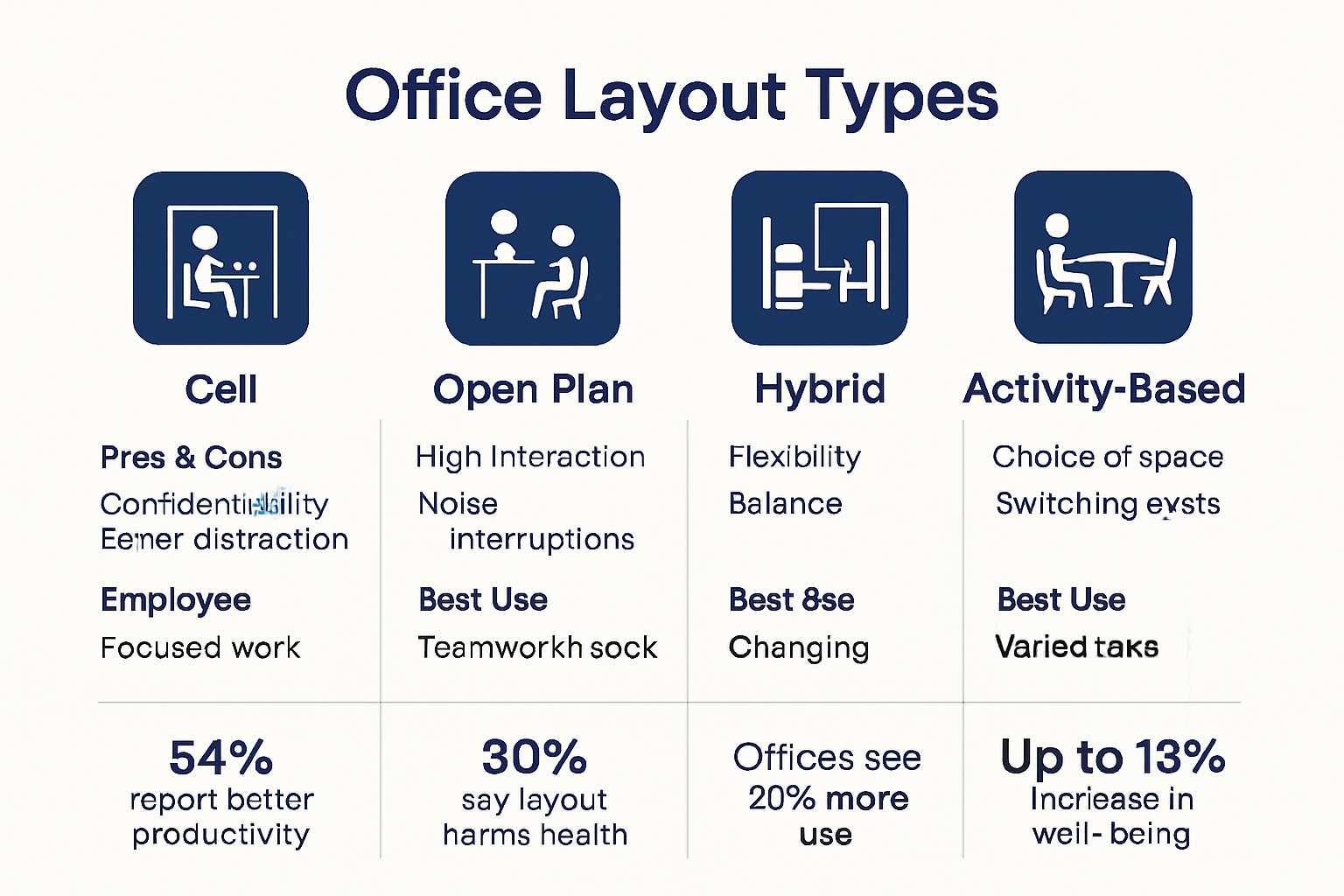
The Future of Office Design: Trends and Innovations
Office design is undergoing a transformative revolution, driven by technological advancements, changing work cultures, and a deeper understanding of human performance. Future workspaces are emerging as dynamic, adaptive environments that prioritize employee well-being, technological integration, and organizational flexibility.
Technological and Environmental Integration
Smart office technologies are redefining workspace functionality, creating intelligent environments that respond dynamically to human needs. These innovations go beyond traditional infrastructure, incorporating advanced sensors, artificial intelligence, and adaptive systems that can modify lighting, temperature, and spatial configurations in real-time. Such technologies enable workspaces to become responsive ecosystems that optimize employee comfort and productivity.
Key technological integration trends include:
- Internet of Things (IoT) enabled workspace management
- Advanced environmental control systems
- Personalized workspace customization technologies
- Augmented and virtual reality collaboration platforms
Holistic Well-being and Sustainability
Future office design transcends mere functionality, embracing a comprehensive approach to employee well-being and environmental sustainability. According to research in Frontiers in Psychology, emerging design philosophies emphasize creating workspaces that support physical, mental, and emotional health while minimizing environmental impact.
This holistic approach integrates biophilic design principles, which incorporate natural elements like living walls, abundant natural lighting, organic materials, and green spaces. Such design strategies not only enhance aesthetic appeal but also contribute to improved air quality, reduced stress levels, and increased cognitive performance.
The future of office design represents a profound shift from traditional, static environments to dynamic, human-centered spaces. By embracing technological innovation, prioritizing employee well-being, and maintaining environmental consciousness, organizations can create workspaces that are not just places of work, but catalysts for creativity, collaboration, and sustained human potential.
Elevate Your Office Design with Practical Floor Solutions
If you are inspired by the power of purposeful office design, do not overlook the foundation of every workspace: the floor. The article highlights how spatial configuration, safety, and visual identity shape productive environments. One common pain point is finding reliable, stylish solutions that balance safety and aesthetics in high-traffic areas. Mats4U.com tackles these challenges by offering commercial floor mat options that align with your vision for modern, ergonomic workplaces. Choose from our specialized Non Slip mats for secure walkways, or enhance your branding with Fabric Logo Mats that add a personal touch to any office reception.
Upgrade your workspace design today and support employee well-being while extending your brand presence throughout the office. Visit Mats4U.com now to explore durable matting solutions that fit your unique office inspiration. Do not wait to make the first step toward a safer, more inspiring environment with products designed for lasting impact.
Frequently Asked Questions
What are the key elements of effective office design?
Effective office design emphasizes spatial configuration, flexibility, ergonomic considerations, technology integration, and sensory experiences. It aims to create functional spaces that adapt to various work styles and enhance employee performance and well-being.
How does office design impact employee productivity?
Office design directly influences employee productivity by creating environments that support focused work, collaboration, and psychological comfort. A well-designed workspace can reduce stress, enhance motivation, and improve job satisfaction, ultimately leading to higher productivity levels.
What role does ergonomic furniture play in office design?
Ergonomic furniture is crucial in office design as it promotes proper posture and reduces the risk of workplace injuries. By minimizing physical strain and discomfort, ergonomic elements contribute to improved employee health and sustained cognitive performance.
What trends are shaping the future of office design?
The future of office design is being shaped by technological integration, flexible workspace configurations, and a focus on employee well-being and sustainability. Innovations like smart office technologies, biophilic design, and adaptive environments are prioritizing comfort and productivity in workspaces.


